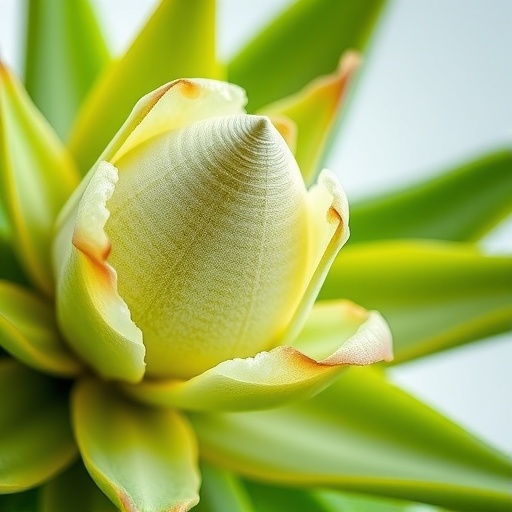Nanocellulose, a versatile and sustainable material derived from natural sources, has gained significant attention in recent years for its promising applications in various fields. Among the abundant agricultural resources, agave plants have emerged as a noteworthy source for nanocellulose extraction. In a comprehensive review, researchers delve into the methodology of obtaining nanocellulose from agaves, its characterization, and its potential applications, particularly in food packaging and Pickering emulsions.
The process of extracting nanocellulose from agave plants involves several sophisticated techniques that highlight the unique properties of this natural polymer. Researchers begin by breaking down the agave fibers through a series of mechanical and chemical processes. These methods often include grinding, bleaching, and enzymatic treatments, which work together to liberate nanofibers from the cellulose matrix. The resulting nanocellulose exhibits remarkable mechanical strength, high surface area, and excellent biocompatibility, making it a prime candidate for various applications.
Characterization of nanocellulose is a crucial aspect of understanding its potential uses. In this review, the authors employ several advanced analytical techniques to characterize the nanocellulose extracted from agaves. Techniques such as scanning electron microscopy (SEM) and atomic force microscopy (AFM) are utilized to visualize the structure and morphology of nanofibers. Additionally, X-ray diffraction (XRD) and thermogravimetric analysis (TGA) provide insights into the crystallinity and thermal stability of the nanocellulose. Such thorough characterization is essential in determining the suitability of nanocellulose for specific applications.
One of the most exciting areas where nanocellulose from agaves can be applied is in food packaging. The global demand for sustainable packaging solutions has intensified as environmental concerns grow. Traditional plastics contribute significantly to pollution and waste, prompting researchers to explore biodegradable alternatives. Nanocellulose, being biodegradable and derived from renewable sources, presents an attractive solution. It not only enhances the mechanical properties of packaging materials but also improves barrier properties against moisture and gases, thereby extending the shelf life of food products.
Moreover, the integration of nanocellulose into food packaging can introduce functional properties such as antimicrobial activity. The review highlights studies where nanocellulose composites have shown effective inhibition of microbial growth, thus ensuring food safety. This inherent property can be leveraged to create packaging that not only protects the contents but also actively contributes to food preservation.
In addition to its applications in food packaging, nanocellulose from agaves is gaining traction in the formulation of Pickering emulsions. These emulsions, stabilized by solid particles rather than surfactants, have advantages such as increased stability and reduced need for chemical additives. The ability of nanocellulose to stabilize emulsions without the use of traditional surfactants opens up new avenues for formulating oil-in-water and water-in-oil systems that are more environmentally friendly.
The review also emphasizes the importance of customizing the properties of nanocellulose for specific applications. By varying the extraction methods and conditions, researchers can tailor the size, surface charge, and degree of crystallinity of nanocellulose, enabling its optimization for diverse uses. This versatility positions nanocellulose as a key player in the development of innovative materials for various industries.
In exploring the economic aspects of producing nanocellulose from agaves, the authors discuss the potential for utilizing agricultural waste. Agave plants, cultivated primarily for the production of alcoholic beverages and fibers, often generate substantial amounts of waste. By extracting nanocellulose from this waste, researchers highlight the dual opportunity of reducing environmental impact while creating valuable products. This synergy aligns with the principles of a circular economy, where waste is transformed into resources.
The environmental implications of utilizing agave-based nanocellulose are profound. As consumers and industries alike seek sustainable materials, the shift towards biobased polymers presents a viable solution to mitigating plastic pollution. The review underscores the significance of adopting materials derived from renewable sources, emphasizing the role of nanocellulose in creating eco-friendly packaging alternatives that resonate with environmentally conscious consumers.
As the interest in nanocellulose continues to grow, the review encourages further research into developing scalable production techniques. While the current methodologies showcase promising results, the challenge remains in optimizing these processes for industrial applications. Researchers are urged to explore avenues that enhance the efficiency and cost-effectiveness of nanocellulose extraction, paving the way for broader adoption in various markets.
Ultimately, the review by Manzanares-Meza et al. serves as a catalyst for future explorations in the field of nanocellulose derived from agaves. By showcasing its potential applications in food packaging and Pickering emulsions, the authors contribute to the growing body of knowledge that positions nanocellulose as an innovative and sustainable biomaterial. As the world grapples with environmental challenges, the exploration of natural resources like agaves holds the promise of creating functional materials that are not only beneficial to the economy but also to the planet.
This comprehensive evaluation provides valuable insights into the versatility of nanocellulose, encouraging interdisciplinary collaboration among researchers, industry stakeholders, and policymakers. The call for action is clear: harness the potential of agave-derived nanocellulose to drive innovation in sustainable materials, ultimately leading towards a more sustainable future.
In conclusion, the literature surrounding nanocellulose from agaves offers a glimpse into the future of biomaterials. The balance between advanced material properties and environmental stewardship represents a pinnacle of research and innovation that aligns with global sustainability goals. As the findings from this review circulate within the scientific community and beyond, they are likely to inspire a wave of new projects focused on harnessing the capabilities of this remarkable bioresource.
Subject of Research: Nanocellulose from agaves and its applications
Article Title: Nanocellulose from Agaves: Obtention, Characterization and Potential Application in Food Packaging and Pickering Emulsions—A Review
Article References:
Manzanares-Meza, O.A., Morales-Castro, J., Ruiz, H.A. et al. Nanocellulose from Agaves: Obtention, Characterization and Potential Application in Food Packaging and Pickering Emulsions—A Review.
Waste Biomass Valor (2025). https://doi.org/10.1007/s12649-025-03399-6
Image Credits: AI Generated
DOI: https://doi.org/10.1007/s12649-025-03399-6
Keywords: Nanocellulose, agave, food packaging, Pickering emulsions, sustainable materials




